This post is sort of inspired by Randall Munroe.
It’s an idea that pops up now and then in the bike world: What if, one morning, we all drove cars instead?
That’d teach the naysayers a lesson.
Or would it?
Well, let’s find out.
How many bike commuters own cars?
Here’s the first thing to figure out: How many people riding bikes to Portland jobs actually have cars at home?
As with a lot of these questions, a Census data set released last fall, covering the years 2006-2010, is going to be a huge help here. Though the share of bike commuters is somewhat higher today than in the early years of that period, it’s not a dramatic difference, so the demographics of who’s biking probably haven’t changed a ton.
Of 15,130 people who biked to Portland jobs over those years, 2,460 didn’t have cars at home, and another 5,730 lived in one-car households. According to different Census data, 47 percent of one-car households in the Portland area have two workers; let’s assume this ratio holds for households with bike commuters, and that such households are evenly split between those where both workers leave the car at home and those where one worker car-commutes while the other bikes.
Let’s also assume that 350 bike commuters who don’t own cars managed to commandeer every single car2go in the city for one day.
2,460 people from no-car households biking to jobs in Portland
5,730 bike commuters in one-car households x 47% with a second worker x 50% where the second worker takes the car = 1,347 other bike commuters without car access
350 bike commuters taking car2go
2,460 + 1,347 – 350 = 3,457 bike commuters who couldn’t drive to work even if they wanted to
15,130 Portland bike commuters – 3,457 without car access = 11,673 Portland bike commuters with car access as of 2006-2010 (which means about 75% of Portland bike commuters have access to a car)
As I mentioned, the number of bike commuters to Portland jobs has increased somewhat since then: from about 15,130 to 18,584 as of 2012, a 23% increase. We also know that typical Hawthorne Bridge bike counts haven’t risen since 2012, so let’ s assume the 2012 numbers hold:
11,673 * 123% = 14,357 Portland bike commuters with car access today
Dreaming about a show of strength? If you could get every bike-commuter in Portland to join, that’s how many commute cars you’d be adding to the roads.
How many cars are on the road already?
This question is easier. As of 2012 we had 271,932 drive-alone commuters, 32,384 people in two-person carpools, 7,201 in three-person carpools and 2,092 in carpools of four or more. So:
271,932 + 1/2 of 32,384 + 1/3 of 7,201 + 1/4 of 2,092 = 291,047 cars headed to Portland jobs
Yikes. That’s a lot of cars. How much difference would the “day without the bicycle” make?
14,357 / 291,047 = 4.9 percent more cars if every biker with car access drove to work
What would that look like? Well, here are a couple moderately crowded downtown Portland intersections, roughly to scale, with 50 cars:
And here’s what they would look like with 4.9 percent more, 53 cars:

Hm.
What if we look specifically at downtown?
But maybe we’re giving bikes short shrift. What if we look specifically at the part of Portland with the most bike commuters: downtown?
Let’s look at the four Portland Census tracts with the most bike commuters: the central business district south of Burnside (2,530 bike commuters), Old Town north of Burnside (700 bikes), the Pearl area (515) and the Portland State University area (495).
2,530 + 700 + 515 + 495 = 4,240 bike commuters downtown as of 2006-2010
4,275 x 123% = 5,215 bike commuters downtown today
Advertisement
But because Census numbers don’t include students, let’s also count the 2,651 PSU students who bike to class (keeping in mind that many don’t actually commute every day and that for many, it’s a very short distance).
5,215 + 2,651 = 8,653 bike commuters downtown including PSU students
Now, of those, how many could drive if they wanted to? We’ll assume the downtown workforce follows the metro-area trend and that 75 percent of bike commuters have car access, plus 20 percent of PSU students. (We’re ignoring parking here: PSU and many downtown garages are pretty close to their daily parking capacity. But if we filled every street space and garage and also evicted every food cart, maybe this could fit.)
5,215 x 75% = 3,911 downtown worker bike commuters who could opt to drive
2,651 x 20% = 530 PSU student bike commuters who could opt to drive
3,911 + 530 + 350 car2go users = 4,791 downtown commuters and PSU students who could opt to drive
How does this compare to the number of downtown and PSU commuters with cars? I’ll spare you the math, but using the same formula as above, downtown has 39,394 cars from workers and another 5,007 or so from PSU students. That’s 44,401 cars downtown.
4,791 / 44,401 = 11%
So this is our answer:
If every downtown bike-commuting worker and PSU bike-commuting student with car access drove to work on the same day, downtown car-commute traffic would increase about 11 percent.
(This assumes that zero cars are on the road for anything except commuting. If anybody were using cars for anything else, the congestion impact would be smaller.)
What does this look like? Here’s that image of 50 cars:
And here’s 55 cars:
Hmm.
Are you ready for this, Portland? Here’s the hard truth:
Even in Portland, an organized “day without the bicycle” would have very little effect on congestion.
Even in the bikingest part of the bikingest major city in North America, getting every single bike commuter with a car to drive to work for one day — a participation level that wouldn’t be anywhere close to achievable anyway — would barely increase auto traffic more than the normal day-to-day fluctuation on any given street. Overall, the impact would be 10 percent in the central business district, 11 percent in the Pearl, 9 percent in Old Town and 11 percent in the PSU area.
Epilogue: On the other hand
But before you get depressed, here’s the other side of the coin.
What is it, exactly, that “day without the bicycle” dreamers envision? Hours of mind-numbing congestion on our freeways? A huge gouge out of our regional labor productivity? Freight traffic crawling to a job-killing standstill?
This already happens in Portland. It happens every single day.
The real truth behind the “day without a bicycle” is that in the United States — even in Portland — every single day is a day without the bicycle.
Every single day is a day that people who truly need to drive are sitting in needless congestion.
Every single day is a day we’re killing jobs by trapping semis on needlessly congested freeways.
Every single day is a day when a huge share of the population could be reaping all the joys and benefits of getting where you need to go with your own muscles, but isn’t.
We don’t need more “days without the bicycle” in the United States.
We need many, many fewer.
– Read more of our Ask BikePortland columns here.


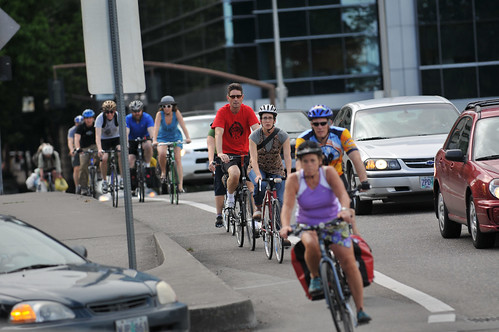
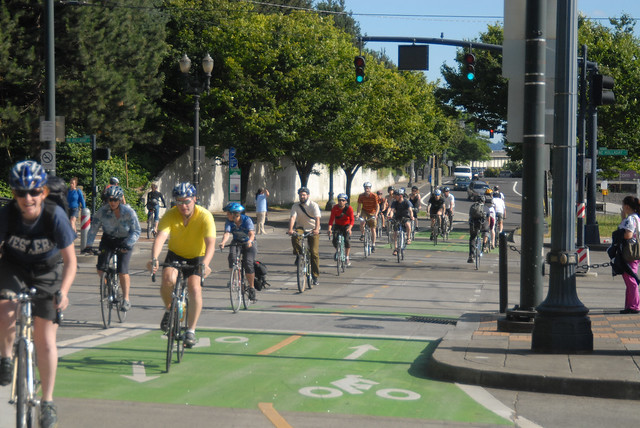


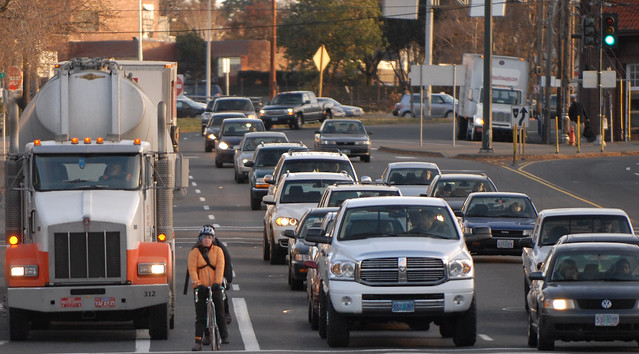





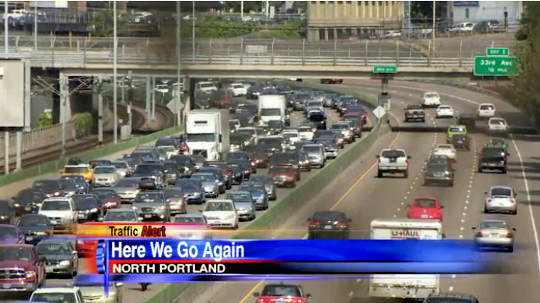
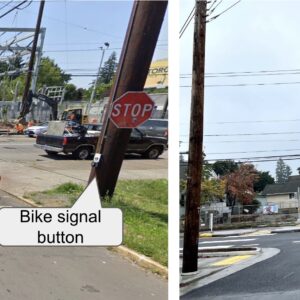
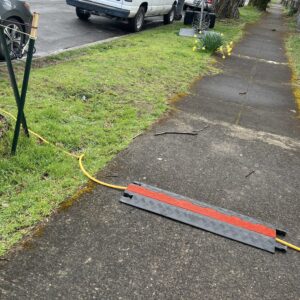


Thanks for reading.
BikePortland has served this community with independent community journalism since 2005. We rely on subscriptions from readers like you to survive. Your financial support is vital in keeping this valuable resource alive and well.
Please subscribe today to strengthen and expand our work.
And every single day is a day I’m not stuck in traffic with the rest of them. Hallelujah.
Maus or Andersen,
Curious if either of you have done a month without a bicycle (recently) mainly commuting by car, only using public transit for a limited amount? Would be a worthwhile study/investigation for you guys especially if it were coming from further out such as the beaver or sandy.
Hi Sho,
nope. I haven’t used a car to commute since I moved to Portland. I do, however, drive our family’s mini-van from time to time. And whenever I do drive I consider it good research that helps me better understand the driving perspective. (Interestingly, many people who argue against bicycling have no relevant bicycling experience to draw from.) I also use the bus and MAX from time to time…enough so that I “get it” when it comes to using other, non-bicycling modes.
Its good to stay well balanced in both modes of transport if you are arguing such facts that you present on your website however using a vehicle time to time (mainly not doing typical work commute) doesn’t really help your arguments. I have both a car and a bike, using the bike to commute simply because it is quicker however many of the arguments you make ignore those that dont have the option to bike in (whether due to commute distance, finances, disabilities, etc) but lean towards bicycling is king no matter what ignoring how such changes would negatively effect 10s of thousands (100s of thousands in a denser city). Id suggest you toss the bike aside for a month (i know its gonna suck) especially if you havent even done so while living here yet preach about not driving here and possibly start interviewing those on the opposite side of the spectrum.
Sho,
I don’t agree with your characterizations of my arguments. I do not think “bicycling is king no matter what.” I also try to be very careful not to “preach” any specific type of behavior and I also always try to keep all viewpoints in mind (and publish them on the site). All that being said, I hear you and I appreciate the feedback.
Sho, interesting viewpoint and I suggest that similar comments be written to all transportation related journalists asking them how often they do a month without a car so they can have balanced reporting.
Joe Rose at The O is a bike commuter much of the time and many of his articles are the Us vs. Them type…
Joe is a very level headed guy, I get the feeling that the tone of his articles would be much less sensational if the O weren’t signing his paychecks and breathing over his shoulder.
I disagree Joe is level headed. He sure does try to present himself that way. I had an email exchange with him that proved to me he really didn’t get it. For a bike commuter he’s fairly car-oriented in my opinion.
Agreed, they should.
I often read internet comments that say the “car is king” and that the “people have chosen the car”. They say that not everyone is able to ride a bike, while at the same time failing to consider the flip side of that argument: not everyone can DRIVE, for legal, financial, health or other reasons. Those folks need a safe way to get around too.
Also, statistics will tell you that most cyclists are very familiar with driving, as most cyclists own and use a car regularly. The same cannot be said for most drivers.
Tis true, its getting the reporters to understand the importance of knowing and utilizing both sides. Its the internet, anyone can blast a bunch of bs but hopefully if those people are becoming voices within the community they are level-headed making appropriate judgements/decisions for both sides. Portland doesn’t stop at 39th or even 82nd, but is growing and will continue with the burbs.
Hey, Sho. I last commuted by car in 2009, when I lived in NoPo’s Kenton neighborhood and alternated between bike, car and occasionally bus commuting across the I-5 bridge to downtown Vancouver. All three options sort of sucked for different reasons.
After I quit the Vancouver job, I got a monthly TriMet pass (2010-2012). I rarely used my bike for downtown trips; I almost always took the MAX. Then I stopped getting the monthly passes and realized I liked biking downtown, too.
Today I bike for almost every trip. I budget $100 a month for the occasional lazy luxury of MAX, bus or car2go.
A few times a month, I use car2go for something, or I ride in or drive my girlfriend’s occasionally-used car. Pay-by-the-minute carsharing has actually taught me some really valuable things about efficient use of cars, I think:
1) Never ever drive during rush hour unless you absolutely have to.
2) By far the most efficient way to use a car is to start using it right next to the onramp of an uncongested freeway and to stop using it immediately after exiting the freeway.
I don’t see it as a car vs bike argument at all. I use both frequently, but prefer it when I can go by bike. I wouldn’t ask my neighbors to stop driving to work and bike instead — I’d like just like them to drive LESS. Combine their trips. Commute earlier in the morning. Bike part-way to work once a month, or a couple of times in the summer. Stop sitting in an idling car in a parking lot (people do this near my work all the time and it drives me crazy). Go for a ride with your family instead of driving to the mall. Every gallon of gas costs taxpayers $11/gallon – stop throwing my money away.
Do it again as research and a story, keep your perspectives broad in order to make appropriate judgement. What’s the point of the argument if you don’t understand the other side?
And traffic is laughably light in Portland compared to other us metro areas – a function of our quaint size, not our progressive commuting culture
Who’s stopping ODOT from putting up some big banners/signs above 5 and 84 that say ‘Hey, we noticed you’re super stuck in that traffic, have you tried riding your bike the 4 miles to work?’
The hate mail would be epic. I like it.
But seriously, you could even word it to elicit the least amount of hate mail from cantankerous folks. Wouldn’t it be in ODOT’s self interest to reduce congestion? I’m certain that those fancy new signs ( the ones that estimate the highway commute times ) could be used to send the message. How much could it cost to schedule a message on those, $10? I’d fork up the $10 myself.
A fantastic idea. And one that the German federal government has used occasionally, but linked to climate change rather than commute stress.
Kopf an, Motor aus. Für null CO2 auf Kurzstrecken.
Turn on your head, turn off your engine. For zero CO2 for short distances.
http://www.kopf-an.de/
And has anyone seen a TV traffic report that said, “All the bike lanes are clear and free-flowing!” ??? I haven’t.
Because ODOT would then need to make sure they swept the shoulders of the roads they maintain more than once a year.
And they’d have to re-train all their landscaping workers to not push all the landscaping debris into the bike lane, or to at least pick it up as they go along and not just leave it there.
That’s apparently asking too much of ODOT, from my experience down here in Tigard.
But even a 5 or 10% increase in traffic can lead to significant congestion!
If a motorway, such as I-84, is currently at 80% of max capacity on an average workday, it would be at Level of Service D: speeds about 45 to 50 mph, difficult to pass, occasional slowing at on-ramps. Add 5% more cars, and you get LOS E or F: stop and go traffic.
This happens often, already, when there is a big sporting event at the Rose Quarter, or if an car crash closes an alternate route.
Add 10% more cars heading downtown, and I-5, I-80, 26, 405, and some of the Willamette bridges would be at high risk for stop-and-go traffic jams, even without a crash. This would lead to more traffic on main streets as well.
Cities like Portland tend to hover just at the level of severe congestion at rush hour: people take Trimet or bike partially because the traffic is already bad. It doesn’t take much additional traffic to go from bad to horrible.
This is true — my sketches aren’t actually traffic engineering, and my back-of-the-envelope Census math isn’t actual demand modeling. That’s why I made many assumptions here that overestimate the impact (the notion that every single biker would join an action like this; the fact that I didn’t consider trip length at all). That said, good points.
you’re also adding 10% more drivers that don’t drive often and may not be that great at it… they’ll be driving slower and making more corrections… these aren’t your usual commuters… they may cause crashes that snarl traffic…
Here’s a different hypothetical: what if we lobbied PBOT with demand instead of begging for supply?
Since the 28th project became a mess, I’ve made a point of using that street whenever possible and taking the lane. Everyone should. It’s much slower and flatter than it looks.
“Build it and they will come” can’t beat “we’re here, get used to it” pragmatism. The stream carves its own bed.
YES! THat is my philosophy! And here in the ‘Couve, that is pretty much how I ride, everywhere. And WA doesn’t have a mandatory side path law, so if the bike lane is 2 feet wide, playing hide and seek, or what ever, I don’t ride in it.
I don’t ride a bike for anyone else’s benefit. I ride because it is FUN.
That is fine, of course, and a very individualistic take on the subject; but you can probably appreciate that this subject (biking for transport) touches on much more than fun, and that folks thinking strategically about these details can benefit everyone, give more people the opportunity to have fun biking, might even help us anticipate the day when the car-as-default-option has disappeared.
I have to admit, I occasionally drive to work. Every time I do, I say to myself “Wow, I’m glad I don’t have to do this every damn day!”
imagine getting the transit users and pedestrians to join in the drive to work day!
“Even in Portland, a “day without the bicycle” would have very little effect on congestion.”
Phooey!
What you’ve shown with the calculations here is that the day-without-the-bike would have very little effect on traffic _volumes_. This is most decidedly not the same thing as congestion, which occurs when volume at a given facility or intersection approaches its capacity. When it comes to congestion (we can use delay per vehicle as a proxy, which is what the infamous level-of-service metric measures), the effect of increasing the volumes by a certain number is most decidedly non-linear, and depends heavily on existing volumes and overall capacity. Increase volumes by 10% in a situation where there’s plenty of extra capacity, and you won’t add much if any delay. But increase volumes by 10% in a situation where volumes are at 90-some percent of capacity, and you’ve just created a nightmare of a traffic jam.
The interesting thing is that many of our most important roads and intersections often hover around 90-some percent of capacity since, above these levels, people will start looking for different, less-direct routes. So I’d posit that in some locations, you’d indeed be creating a LOT of new congestion.
That said, the bigger issue in my mind in parking. I have no idea where you’d fit an extra 4,800 cars downtown while their occupants while away the day working in an office or cubicle that’s probably smaller than the space their car would require. It’d be interesting to know how many unoccupied spaces there are midday downtown on average, but I’d bet you a glass of Amaretto that it’s less than 4,800. The view we share from our respective offices is a parking lot that has less than 100 cars on it as I write. Picturing 47 more of those makes my head hurt.
That’s fair, Brian – I’ve changed my claim to “an organized ‘day without the bicycle.'” See also my reply to Joseph above. Good points.
All of that said, I just did the calculations for two intersections that I have good data for: SW 4th & Salmon, and N Vancouver & Alberta. Delay per vehicle increased by about 1 second at each intersection when you traded all the bikes in for cars, or roughly around 10%. Exactly what Michael claimed.
Moral of the story: Never listen to a traffic engineer regarding the effects of bike stuff. It’s all pedantry.
Or a columnist. 🙂
I was just in Europe, and my experience there suggests one change that could dramatically reduce car travel (as well as the size of cars themselves) with no additional policy changes: Double the price of gas, with additional revenue going to maintaining existing infrastructure and improving non-auto means of transport.
If only.
I’ve been hoping for this for longer than I’ve been avoiding cars…
An excellent idea. And one I’ve heard suggested here with some frequency, less so by spineless officials and their handlers.
Also, raise the price of parking!
“Champs”
“The stream carves its own bed”
nice
Michael,
Really awesome. This is a fun exercise. Of course, based on the same Census data, “leaving the bike at home” wouldn’t have as much impact in the areas that need the most relief from congestion.
From a story about “driving light” that I wrote last fall:
http://www.oregonlive.com/commuting/index.ssf/2013/09/driving_drops_but_portland_gri.html
In the past 10 years, passenger vehicle ownership has increased by only 4 percent, even as Oregon’s driving-age population jumped 14 percent, Oregon Driver and Motor Vehicle and U.S. Census statistics show.
In a few areas, vehicle registration has grown with the population. Since 2002, for example, the number of Washington County residents has surged 16 percent to 547,672 and the number of registered passenger vehicles is up 14 percent to 418,265, suggesting that development patterns, industrial expansion and TriMet cuts in the fast-growing county have left it as car-dependent as ever.
But in Multnomah County, as bicycle commuting, car sharing and transit use has transpired at a revolutionary pace, the number of registered vehicles grew by less than 1 percent, even as the population grew by 11 percent.
Take another route, Hawthorne Bridge or Broadway Bridge and calculate what happens to those when people drive instead of bike.
It isn’t about the whole metro area, it’s about the downtown core. Hawthorne is commonly 18-22% bicyclists and 15-25% transit users. Broadways is also about 20% or more bicyclists and the Broadway Street coming into Portland from the bridge to downtown has more cyclists riding in from 8am-10am than motorists going by. Take those choke points and remove the bikes and we’d have carmaggedon!!!!
Anyway, point being, interesting math ya got, but it would indeed be dramatically more catastrophic for downtown than this math at first makes it appear. If everybody on transit AND biking drove we’d be hosed entirely.
Very nicely done Micheal and a very, very fresh piece of writing. Seriously, the way you set this up is a home run. I hope this one goes viral because the “moral” of the story is awesome – it’s a nice surprise and real rip-you-up-off-the-seat moment. Thank you!
I too think this is very well done. Thanks!
I drive up and down I-5 and 205 at times when the job takes me South. All it takes is one driver refusing to cooperate and ‘merge like a zipper’ – or one selfish person doing selfish or obstructive things and an entire chain reaction of lane changing and congestion begins. Every darn day.
Every day. Every on-ramp. Every merge point. Every. Single. Day.
And while I am stopped FOR NO OBVIOUS REASON – which happens incessentaly – I just shake my head and think, wow, will we ever figure this out? It is senseless.
The phenomenon you’re experiencing has been documented: https://www.youtube.com/watch?v=Suugn-p5C1M
It’s not really the fault of bad individual drivers (except when there is a crash). If every car was a Google car, there would still be rush-hour congestion on this road, because it is right at the full design capacity. If you keep 2 or 3 seconds between cars (to prevent collisions if a tire blows out, and to allow people to merge in), one motorway lane can only carry 2000 cars per hour, and at that rate it will be slow-and-go. Every on-ramp and merge causes a slowdown, because the traffic flow just can’t take on more cars without slowing down.
“…All it takes is one driver refusing to cooperate and ‘merge like a zipper’ – or one selfish person doing selfish or obstructive things and an entire chain reaction of lane changing and congestion begins. …” SE PDX Rider
Automated car technology could eliminate a lot of that behavior. That’s the future. Motor vehicle routing within the city all being managed by central command. Bye bye to the freedom of personal cars, at least during commute and business hours.
and the negative effect on beer, donut, and other “food as fuel” sales…for that day.
Ha. That’s easy.
Now a day without bikeportland, that would be tough.
The Hawthorne Bridge counter says that close to 8k bikes cross that bridge on a nice day. What impact would 8k additional cars crossing the bridge have cause?
I have a hunch that traffic congestion rises more than linearly with the amount of cars on the road. Still, I’m not sure it makes much difference. If you assume, for example, that congestion increases quadratically, than the 4.9% increase in cars that you calculated for Portland as a whole still only leads to a 10% increase in congestion.
Driving in central Portland, it is still uncommon to encounter a situation where all the traffic does not clear within a light cycle. It happens a bit at peak hours, or when a bridge lifts. If you add 10% more cars at peak hours you can expect a lot more gridlock.
Copenhagen changed everything and they started with “No car Sunday”… Instead of looking at what it would look like without bikes, flip it around. What would it look like without cars?!
The analysis needs to focus on choke points. If you sprinkle 10% more cars evenly through the downtown core, that may not be any big deal. If you send 10% more cars through the most congested intersections or bridges, or into the most overfilled parking garages, that may be a big deal.
My one beef with all your number-crunching actually comes at the beginning… where you use census data on commutes as your basis for numbers. In my opinion, the census data on biking is nearly useless because of the way questions are asked, and under-represents cyclists by a significant amount.
For example, the American Community Survey (the yearly questionnaire given to a relatively small number of people, and what I believe your data is based on) uses this: “How did this person usually get to work LAST WEEK? If this person usually used more than one method of transportation during the trip, mark (X) the box of the one used for most of the distance.”
This completely ignores seasonal variance in transportation (“fair-weather commuters”), multi-modal commuters, and those who might bike to work 1-2 days/week instead of 3+ days/week. Not to mention the many people who might bike for non-work purposes. That all just adds up to a lot of potential error.
It is of course possible that your end conclusion could be similar, even with twice the number of bike commuters. But I hate seeing a good discussion started off with inaccurate data!
All true! When I use ACS data I’m usually the drunk looking for his keys under the lampost not because that’s where he dropped them but because that’s where the light is.
In the case of this particular question, though, I’d say commute data is actually pretty useful, because in Portland almost all meaningful congestion is concentrated around the peak commute hours.
http://en.wikipedia.org/wiki/A_Day_Without_a_Mexican
Michael, I wonder if there are any useful averages/estimates to represent the absence of the traffic-calming effect from the presence of bikes in the roadway, i.e. increased average speeds, increased likelihood of crashes & injuries, increased severity of injuries, etc.
Not sure if anyone else has made this point, but it is not “all the people riding bicycles that own cars”, because thanks to having some infrastructure you have a lot of people living without cars, it’s “All the people on bicycles who would have to have a car without bicycle infrastructure”. Or IOW 95% of the people currently riding bicycles for their commute. That would be thousands of cars dumped into streets that could never handle the throughput, akin to if not outright gridlock, especially at bridges and other chokepoints in the grid.
Nice post, overall.
It would’ve been a more complete picture if parking had been considered. After all, once you’ve driven to work, your car will be sitting to occupy slot F for the following 7-10 hours. Multiply x 8,600 downtown workers and students who suddenly drive in that day, and you have one hell of land shortage that day.
“Traffic congestion rises more than linearly with the amount of cars on the road.” From what I’ve read on traffic engineering, the relationship is very far from linear. The difference between relatively free-flowing and heavy congestion (sequential queue failure at lights, stop-and-go on longer stretches of road) can often be just a few percent.
Wonderful article!
We actually pretty much do this experiment already in the winter time. When it’s really nasty out there are hardly any bikes out (except me – unless it’s icy).
Except that when the snow flies a lot of drivers stay home or take TriMet, tweaking too many variables for that to be a useful experiment in what happens when cyclists stop cycling.
I wonder what the roads would look like if you took away bikes, buses, and trains from the equation. As in, no option other than to drive. Makes you wonder if people would beg for alternatives or continue to sit in the endless congested freeways and arterial roads.
I’m glad I have a car for those times I need it, but glad my bike can do 90% of the jobs!
Being in a college town, I’ve wondered about that Census Bureau survey data. Jonathan, are we sure it doesn’t include college students? For some reason I thought it did. But I don’t know. Just wonder where that comes from.
Yep, we’re sure it doesn’t include trips to class – the official Census name of the statistic is “means of transportation to work.” If a student also has a job, though, the way they report getting to that job would be counted.
“the way they report getting to that job would be counted.”
Only if that mode is used for more than 50% of their total yearly trips to work. In other words, many, if not, most “fair weather” bike commuters would not be counted as bike commuters by the ACS.
The nonlinear growth of congestion as a function of traffic volume (or volume/capacity) is modeled by traffic engineers as something like a J-shaped curve. See the figure on page 4 at http://web.pdx.edu/~bertini/papers/Bertini2005Dist6_Paper.pdf
It would be kind of like those bad weather days when cyclists drive anyways.